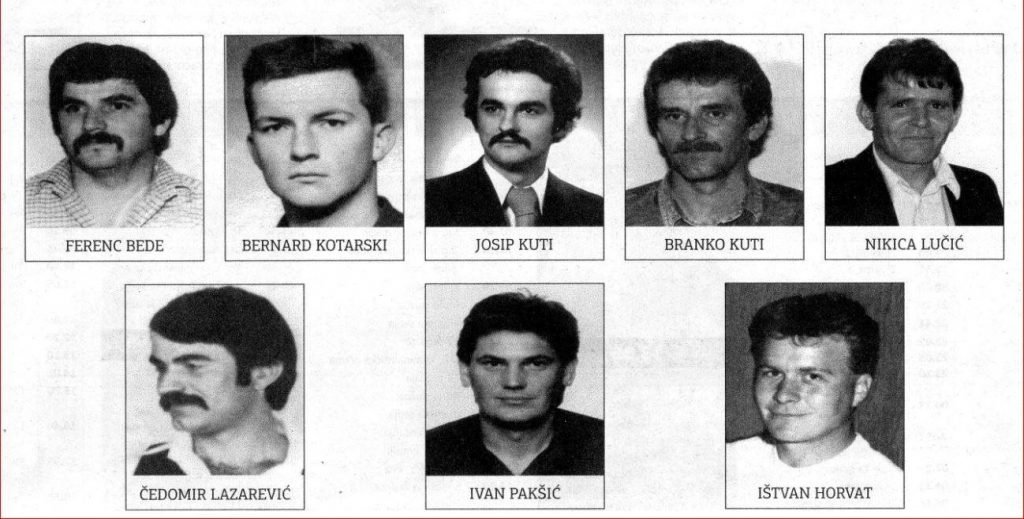On this day in 1991 Bilje became the last village in the Baranja region of eastern Croatia to fall under occupation by rebel Serbs during the Battle of Baranja.
The occupation of Baranja began on 3 July when a column of about sixty tanks and other combat vehicles of the 36th Mechanized Brigade of the 12th Novi Sad Corps of the Yugoslav People’s Army (YPA) entered Croatia from Serbia across the bridge near the village of Batina. By the end of August, the town of Beli Manastir and most of the Baranja region were occupied by the aggressor who expelled the local population predominantly made up of Croats and a Hungarian minority. After the fall of Darda on 22 August 1991, Croatian forces and fleeing civilians conducted a large-scale withdrawal to Osijek. In agreement with the command of the 106th Osijek Brigade, Vladimir Velki organized and led a group of volunteers in the “Plant Company of the Croatian National Guard (CNG)” to return and defend Bilje. On the night of 2 September, Velki submitted the names of 72 volunteers prepared to defend Bilje by order of the 106th Brigade.
Following a heavy mortar attack on Bilje in the early morning of 3 September, the aggressor launched a ground assault with troops comprised of local rebel Serbs and irregular Chetnik volunteers from Serbia supported by YPA tanks. Armed with only rifles and one rocket launcher, the small amount of Croatian forces could not defend themselves against 800 infantry troops assisted by tanks. After fierce fighting, a withdrawal was ordered and completed in the afternoon but only some 50 Croatian soldiers managed to break through to safety from Bilje. The occupation of Baranja ended only in 1997 when eastern Croatia was returned to government control through peaceful reintegration.
Eleven Croatian defenders were killed in the fighting that day. They were Branko Kuti, Josip Kuti, Ferenc Bede, Bernard Kotarski, Hrvoje Kraljević, Čedomir Lazarević, Josip Lerinc, Ištvan Horvat, Nikica Lučić, Ivan Pakšić and Damir Rončević. Some were captured and later exchanged after a harsh imprisonment but nine soldiers, Željko Filipčić, Stanislav Strmečki, Anđal Zoran, Ivica Krkalo, Ivan Forijan, Branko Strmečki, Stevo Granfilder and brothers Tibor and Janoš Šileš did not survive captivity.


The story of the Šileš brothers is extremely shocking and sad and Tibor’s remains are yet to be found. They were of Hungarian background and volunteered for the Croatian forces in the summer of 1991, Tibor and Janos as members of the National Guard while Sandor became a member of the Ministry of the Interior (MUP) troops. Only Sandor survived being captured that fateful day of 3 September. Tibor was wounded in the arm during the retreat and the brothers took refuge in a basement as they awaited nightfall and another opportunity to escape from occupied Bilje.
The plan was to hold out until the evening and then attempt to break out. We were in our village and knew every corner, every field and we were certain that we would get out of the village safe and sound under cover of darkness. Then at approximately 5:00 PM, Chetniks accompanied by an ambulance made their way through the village and somebody called out for any wounded to come out onto the street. Frightened and still in shock due to blood loss, Tibor ran out and surrendered to them. Our escape plane fell through at that point. They surrounded us, we dropped our weapons and they took us somewhere.
Šandor Šileš
After 177 days in captivity, Šandor regained his freedom through a prisoner exchange but his brothers were not so fortunate. They were taken to Darda where all trace of them was lost. Janoš was murdered and his body was found hanging on a bridge in Bačka Palanka in Vojvodina, Serbia. He was buried in an unmarked grave in a cemetery in Novi Sad and it was only in 2003 that an exhumed body was confirmed to be that of Janoš, who was 34 years of age at the time he was killed. Tibor Šileš was 28 years old when he disappeared and the search for his remains continues.
Cover photo – Facebook page Braniteljski centar Bilje
Sources
Literature
Bilešić, Romana i Mikola Danijela. Nestali u Domovinskom ratu. Zagreb: 24 sata d.o.o., 2017
Taslidžić, Davorin, prir. Crna svitanja. Beli Manastir: Zavod za baranjsku povijesnicu, 2011
Internet
Saša Alilović: „Dan sjećanja u Bilju“, Radio Baranja, access achieved September 1, 2019. https://www.radio-baranja.hr/vijesti/7845-dan-sjeanja-u-bilju.html
TV
TV Kalendar. Croatian Radio-television. author Tomislav Šulj, editor Vladimir Brnardić, 3. rujna 2016.
Magistar sam povijesti. Radno iskustvo stjecao sam u Hrvatskom povijesnom muzeju i na Hrvatskoj radioteleviziji u emisiji TV Kalendar. Autor sam nekoliko knjiga i filmova na temu Domovinskog rata. Osnovao sam i uređujem Facebook stranicu Dogodilo se na današnji dan – Domovinski rat i portal Domovinskirat.hr. Također uređujem i vodim emisiju Domoljubne minute koja se svakog dana emitira na Hrvatskom katoličkom radiju te emisiju Sve za Hrvatsku i Novi valovi dobrote. Vlasnik sam obrta CroHis kojim promičem vrijednosti Domovinskog rata.

